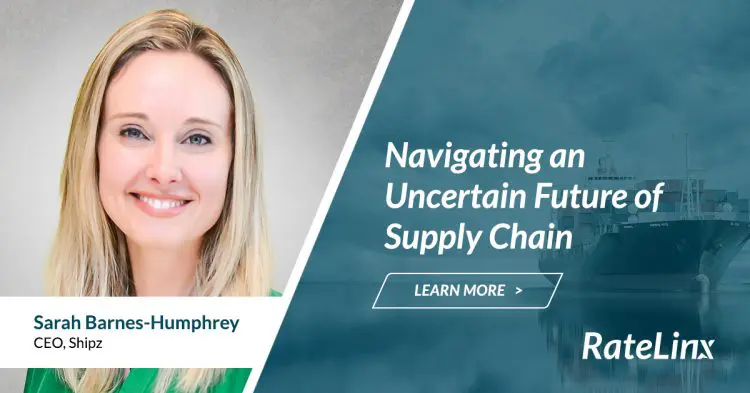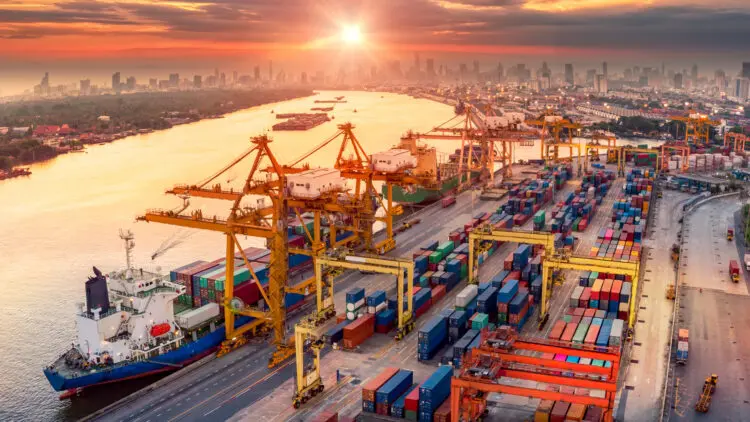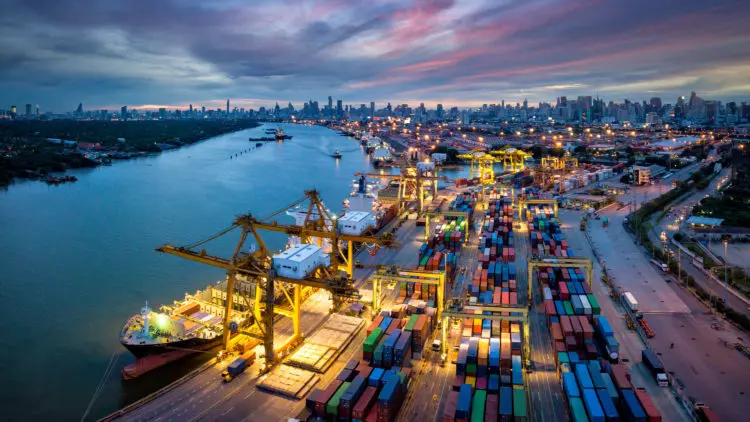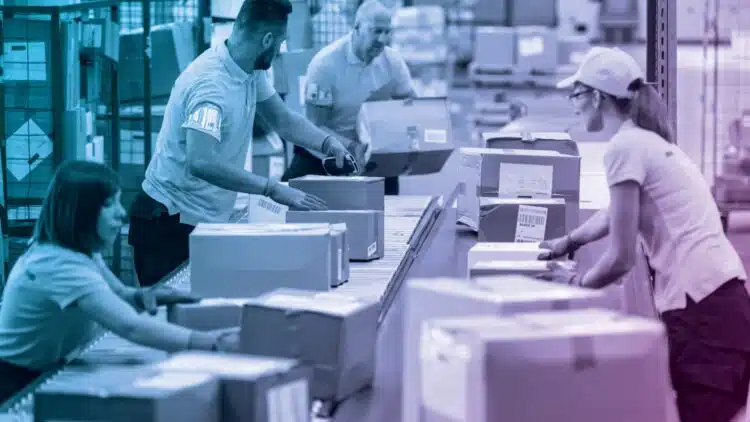2020 was meant to be the start of an exciting new decade for supply chain management. Instead, trade tensions, the COVID-19 pandemic, and mounting economic concerns have all brought uncertainty to global supply chains. Many companies are being cautious in their decision-making when it comes to restoring or reorganizing their supply chains. However, where they may feel certain anxiety or trepidation, Sarah Barnes-Humphrey sees opportunity.
Featured Expert

Sarah Barnes-Humphrey
Sarah Barnes-Humphrey is best-known as the host of the popular Let’s Talk Supply Chain Podcast (LTSC) and The SC, Supply Chain TV channel on YouTube. She’s been named one of the Top 100 Global Women Leaders in Supply Chain.
Recommended Reading:
Sarah is the host of Let’s Talk Supply Chain, an industry podcast and platform for top innovators and supply chain professionals. She’s also the CEO of Shipz, an enterprising logistics company seeking to simplify pricing for ocean and air shipments.
Sarah has a unique vantage point into supply chain: It’s her family business. She grew up in a household of entrepreneurs building a shipping company, where logistics was a common dinner table topic.
We sat down with Sarah to discuss the uncertainties and probabilities that will shape the future of supply chain management.
Find Opportunities in Supply Chain Uncertainty
These are volatile, uncertain times for supply chain leaders. While there are plenty of negative aspects of the current situation, there is also the potential for change. Likewise, for Sarah, uncertainty means the future is undefined, with plenty of opportunities for those willing to look for them.
For instance, one clear opportunity she sees is for shippers and freight forwarders to work together to overcome current market conditions. The two entities need to broker a compromise that brings stability and certainty to both sides of the supply chain. It’s a situation ripe for positive disruption.
“Disruption in international shipping is really to bring the mid-market and the shipping providers together. Right now, there’s a lot of disconnect and both parties aren’t pleased with the current process for a couple different reasons,” Sarah says. “The freight forwarders are doing a lot of work for free and they’re also acting as a bank. Likewise, shippers aren’t getting from freight forwarders what they’re looking for, which is faster costing for their shipments and more technology-driven solutions.”
But Sarah acknowledges that embracing the unknown and brokering a compromise isn’t easy. But, being adaptable takes a willingness to look beyond the familiar. Supply chain needs to go beyond its many segmented parts, to become a more cohesive system. To do that, every party needs to give a little.
“The other thing I would say about international shipping is that it’s a complex space to be in,” she says. “There are a lot of great organizations doing amazing things, but this part of the industry still has a lot of challenges—because traditionally, we’ve always had a siloed approach. There’s been a lot of traditional thinking, and I think collaboration is going to be the key to unlocking that.”
“COVID has shown that we need to use data a lot more prevalently. We need to be more agile. Business models and supply chains are going to change exponentially, and that’s why [in] the next five years, so much can change.”
The Death of the Five-Year Plan
For many industries, monumental changes have always been marked by incremental effort. Change rarely happens overnight. Except now, it needs to.
Supply chains were interrupted at the outset of COVID-19 and continue to face challenges as the pandemic wears on. As a result, five-year plans are virtually nullified. It’s a scary prospect for supply chain managers, but not necessarily as scary as it might seem.
“So much can change in five years, especially now. I talked to somebody on my show about a year ago who said that the knowledge base is changing every 1.5 years. And that was a year ago! I’m sure that it’s even faster today,” Sarah says. When asked what the next five years might look like, her answer is candid. “To be honest, I’m not really sure—but what I can hope for is transparency and visibility across all of the supply chain, as well as collaboration among stakeholders and a community where everyone can thrive.”
For industry leaders, the death of the five-year plan isn’t a reason to panic—it’s an incentive to adapt.
You may also be interested in…
Finding Stability and Resilience
Flexibility is the path to supply chain stability in a post-pandemic world.
“COVID has shown that we need to use data a lot more prevalently. We need to be more agile. Business models and supply chains are going to change exponentially. That’s why [in] the next five years, so much can change,” Sarah says.
Despite the new challenges associated with long-term planning, most supply chain managers have bigger headwinds to face right now: namely COVID-19-related pivots. And while each company will tackle these challenges in their own way, Sarah believes the agility we see today will set the stage for what we can expect for the future of supply chain.
“Companies are planning right now—from the hybrid model of going back to work to globalization, to where their points of manufacturing [are] going to be,” she says. “How are they going to service individual markets, rather than a global market? What is technology going to do to enhance that? How are humans and robots going to work together? I think those are all things that are going to play a hand in the next five years.”
Like what you’re reading?
Smart Technology Usage Is Crucial
Planning in uncertain times means leveraging technology and data into action. But Sarah believes it’s more complicated than plugging supply chain data into systems and making unilateral decisions. Still, companies need first to understand what they’re striving to achieve. Streamlined operations? Better sustainability? More logistical flexibility? It’s not only having the technology on hand; it’s what problems you aim to solve with the technology.
“I think more people, as they take a look at their business models and the future of their business, will be given the time and the space to rethink how they want to do business in the future. How they’re going to embrace technology. How they will be more sustainable. That’s going to be more intentional. It’s going to be more top of mind,” Sarah says.
Technology is the gateway to more informed supply chain management teams. Companies benefit from leveraging better tech into their operations for smarter decision-making. Sarah sees the potential of technology in enabling the people that keep supply chains moving. The technological revolution is about empowering insights from end-to-end, person-to-person.
“I think there’s just so much more that we can do to support supply chain professionals as a whole to make this industry better. I want to see us give more opportunity to more supply chain professionals, wherever they are in their career,” says Sarah.
Three Areas of Focus for Supply Chain Leaders
Digitizing supply chains is only the first step in cultivating success in the future. According to Sarah, there are three prime opportunities companies need to pursue right now.
First, Sarah recommends cross-training supply chain experts on emerging tech. In fact, it’s a necessary marriage of industry education and modern solutions. “There’s not enough expertise in tech. I would implore supply chain leaders to diversify their supply chain teams and hire in the tech sector to support supply chain initiatives,” she says. It might make more sense to hire a tech person you can train in supply chain, rather than vice versa.
Second, Sarah identifies an opportunity for greater collaboration. She sees it as the key ingredient in enabling smarter end-to-end supply chains. “Think about bringing your supply chain team and your IT team together to talk to a potential technology provider. If you haven’t really worked together and neither department knows exactly what the other one really wants, that’s a disaster waiting to happen. You need to have somebody that’s going to bridge the gap.”
Finally, Sarah sees an opportunity to create a knowledgeable, confident team that isn’t afraid of an unknown future and can adapt to the relative unknown. “[Give] time and space to your teams, to spark new ideas. Mentor each other, attend conferences, speak at conferences, etc. Give them an opportunity to learn more!” She says.
Reliance on data, integration of supply chain teams, and investment in social-emotional leadership are all opportunities to create future certainties.
Successful Supply Chain Leaders have Emotional Intelligence
Sarah is fortunate enough to chat with insightful supply chain leaders on Let’s Talk Supply Chain. Perhaps this is why she puts good leadership above all when asked about the best path forward.
Sarah highlights the need for good leadership on the employee side as well as the business side. At the heart of it all, the supply chain is still a people-based sector. The new norm—whatever that may be—is going to be its own form of disruption. Successful leaders will guide not only company success, but team and individual success as well.
“The pandemic has shown what great leaders are made of: Empathy and emotional intelligence (EQ) are key skills moving forward,” she says. “Diversity, ethics, culture—those things are huge. What do you want your teams to look like in the future? How do you want them to lead? It’s not just you leading them—it’s them leading the next generation and bringing new people into the supply chain,” she says.
Invest in Data & Communication to Thrive in the Future
Sarah Barnes-Humphrey will be the first to admit that the future is one big unknown. Especially now, amidst an ongoing pandemic, it’s hard to see exactly what catalysts will drive the biggest changes. Particularly in a complex, global discipline like supply chain.
But she’s not worried. For Sarah and other professionals, success in the future is determined by what companies are doing today. Specifically, reliance on data, integration of supply chain teams, and investment in social-emotional leadership are all opportunities to create future certainties.










